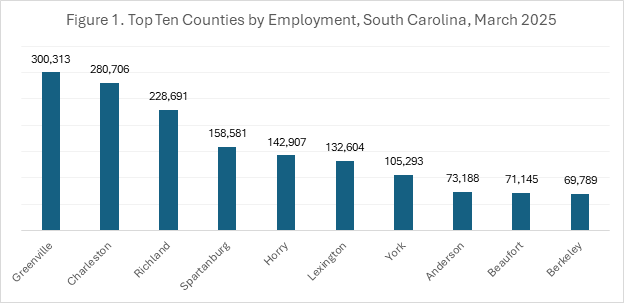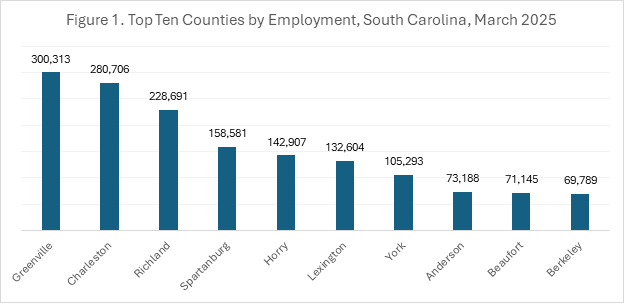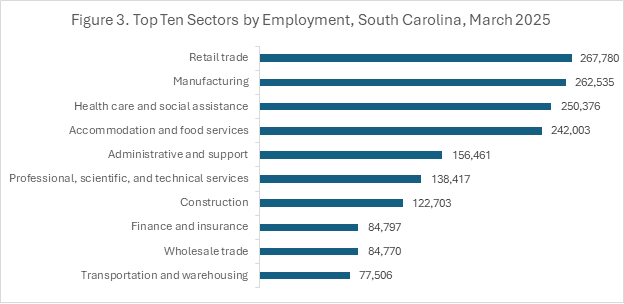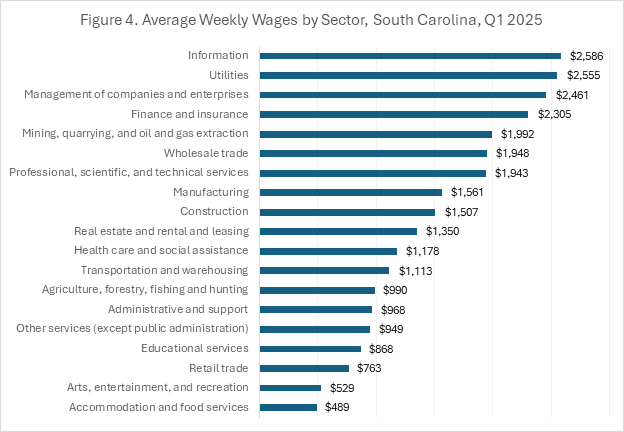Quarterly Census of Employment and Wages: First Quarter, 2025
By Lainey Stalnaker, Data Analytics Writer

The Quarterly Census of Employment and Wages (QCEW) measures changes in employment, establishments, total wages, and average weekly wages at the national, state, and county levels [1]. Data are categorized by sector according to the North American Industry Classification System (NAICS). These data include the monthly employment and quarterly wages for workers covered by state unemployment insurance (UI) laws and federal workers covered by the Unemployment Compensation for Federal Employees (UCFE) program, absent certain excluded groups.
Employment by County
Employment in South Carolina grew 1.7 percent from March 2024 to March 2025, exceeding U.S. employment growth of just 0.4 percent over the same period. South Carolina added 37,652 workers, and total employment reached 2,304,873. Employment grew fastest in Fairfield County at 5.9 percent, followed by Berkeley County at 5.7 percent and Edgefield County at 5.2 percent. Williamsburg and Lancaster Counties rounded out the top five.
Greenville County took the top spot for total employment at 300,313 in March of 2025, followed by Charleston County at 280,706, and Richland County at 228,691. The majority of counties recorded employment growth from March 2024 to March 2025. See Figure 1 for the counties with the highest employment in quarter one. These counties are also the most populous in the state.

Wages by County
Average weekly wages in South Carolina rose 4.4 percent between quarter one of 2024 and quarter one of 2025 from $1,195 to $1,247, an increase of $52. U.S. wages, in comparison, increased 4.1 percent over the same period. Wages increased in nearly every county in South Carolina, but Saluda County recorded the fastest growth at 11.2 percent. Georgetown County followed at 9.1 percent, and Hampton County ranked third at 8.8 percent. 26 out of 46 South Carolina counties recorded faster wage growth than in the U.S. as a whole.
The highest average weekly wages were in Charleston County at $1,412. Berkeley County followed closely behind at $1,403. Average wages in Lancaster County, at third place, were $1,356. Calhoun and Greenville Counties took the fourth and fifth spots, averaging $1,311 and $1,294, respectively. See Figure 2 for average weekly wages in South Carolina’s ten most populous counties.

Employment by Sector
In March of 2025, employment was highest in the retail trade sector, which employed 267,780 people, as shown in Figure 3. The manufacturing sector followed, employing 262,535 people. In third place, 250,376 people were employed in the health care and social assistance sector. The fastest growing sectors were mining, quarrying, and oil and gas extraction at 18.9 percent growth since March 2024; construction at 6.0 percent; educational services at 5.6 percent; and professional, scientific, and technical services at 4.7 percent.
Employment fell in five sectors since March 2024. The steepest decline was in agriculture, forestry, fishing and hunting, which recorded an 8.8 percent drop. Employment in the transportation and warehousing sector fell 3.0 percent, and the information sector’s employment fell 2.6 percent. Employment declined 0.6 percent in both the accommodation and food services sector and the manufacturing sector.

Wages by Sector
Wages were highest in the information sector in quarter one of 2025, averaging $2,586 per week. Utilities came second with average weekly wages of $2,555, followed by management of companies and enterprises at $2,461. Finance and insurance and mining, quarrying, and oil and gas extraction also made the top five, at $2,305 and $1,992, respectively.
Wages increased in every sector since March 2024. The fastest wage growth occurred in the information sector, which recorded a 14.3 percent increase, or an addition of $323 each week. Average weekly wages increased 8.6 percent in the management of companies and enterprises sector (+$194) and 8.0 percent in the construction sector (+$112). Figure 4 shows average weekly wages in all sectors for quarter one 2025.

[1] https://www.bls.gov/news.release/pdf/cewqtr.pdf
